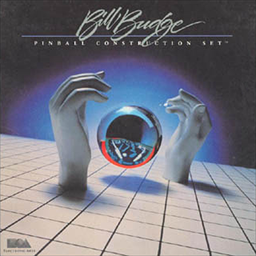
Pinball Construction Set is a video game by Bill Budge written for the Apple II. It was originally published in 1982 through Budge's own company, BudgeCo, then was released by Electronic Arts in 1983 along with ports to the Atari 8-bit computers and Commodore 64.

Carnival is a fixed shooter developed by Gremlin and released by Sega in arcades in 1980. It was one of the first video games with a bonus round.
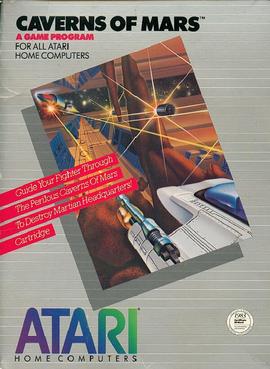
Caverns of Mars is a vertically scrolling shooter for Atari 8-bit computers. It was written by Greg Christensen, with some features later added by Richard Watts, and published by the Atari Program Exchange (APX) in 1981. Caverns of Mars became the best selling APX software of all-time and was moved into Atari, Inc.'s official product line, first on diskette, then on cartridge.

AtariWriter is a word processor program for the Atari 8-bit computers released by Atari, Inc. as a 16 kB ROM cartridge in 1983. The program was fast and easy to use, while still allowing for the creation of fairly complex documents. It was a success for the platform, with at least 800,000 units initially sold, not including international versions and later updates.

Dung Beetles is an Apple II maze game written by Bob Bishop published in 1982 by Datasoft. The gameplay is similar to Pac-Man, but a portion of the maze around the player-controlled character is enlarged as if being viewed through a square magnifying glass.

ANALOG Computing was an American computer magazine devoted to Atari 8-bit computers. It was published from 1981 until 1989. In addition to reviews and tutorials, ANALOG printed multiple programs in each issue for users to type in. Almost every issue included a machine language video game—as opposed to Atari BASIC—which were uncommon in competing magazines. Such games were accompanied by the assembly language source code. ANALOG also sold commercial games, two books of type-in software, and access to a custom bulletin-board system. After the Atari ST was released, coverage of the new systems moved to an ST-Log section of the magazine before spinning off into a separate publication under the ST-Log name.
Synapse Software Corporation was an American software developer and publisher founded in 1981 by Ihor Wolosenko and Ken Grant. Synapse published application software and developer tools and was primarily known for video games. It initially focused on the Atari 8-bit computers, then later developed for the Commodore 64 and other systems. Synapse was purchased by Broderbund in late 1984 and the Synapse label retired in 1985.

Spy's Demise is an action game written by Alan Zeldin for the Apple II and published by Penguin Software in 1982. It was ported to the Atari 8-bit computers, Commodore 64, TI-99/4A, and Vector-06c. The game contains a puzzle which at the time of release could be solved for a Spy's Demise T-shirt. According to Antic magazine in June 1984, only four people had solved it. The game was followed by a 1983 sequel, The Spy Strikes Back.

Many games, utilities, and educational programs were available for Atari 8-bit computers. Atari, Inc. was primarily the publisher following the launch of the Atari 400/800 in 1979, then increasingly by third parties. Atari also distributed "user written" software through the Atari Program Exchange from 1981 to 1984. After APX folded, many titles were picked up by Antic Software.
Tom Hudson is an American programmer best known for co-creating the 3D modeling and animation package 3D Studio as well as creating its precursor, CAD-3D for the Atari ST.
Russ Wetmore is an American programmer and video game designer best known for writing commercial games and applications for Atari 8-bit computers in the early to mid 1980s. His Frogger-inspired Preppie! was published by Adventure International and praised by reviewers for the music and visuals. He also wrote the maze-game sequel, Preppie! II. Wetmore stopped writing games after the video game crash of 1983 and developed the integrated HomePak productivity suite for Batteries Included. He has remained in software development in director and architecture roles.
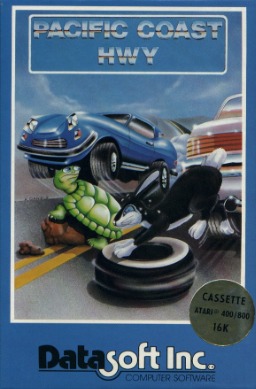
Pacific Coast Highway is a video game written by Ron Rosen for Atari 8-bit computers and published by Datasoft in 1982. It is a clone of Frogger, with the key gameplay differences being that Pacific Coast Highway allows two-player simultaneous play, and the road and water segments are split into separate, alternating, screens.
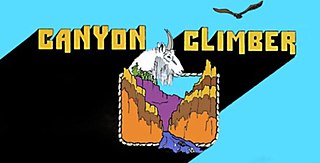
Canyon Climber is a video game designed by Steve Bjork and James Garon for the TRS-80 Color Computer and published by Tandy Corporation in 1982. Ports to other home computers were published by Datasoft. Canyon Climber is a three-screen platform game with an American Southwest theme. Two of the screens are direct analogs of those in Donkey Kong.

Chopper Hunt is a side-view shoot 'em up written by Tom Hudson and published by Imagic in 1984 for Atari 8-bit computers and Commodore 64. It was one of the last games from Imagic before the company went out of business. Chopper Hunt is an enhanced version of the Atari 8-bit game Buried Bucks released by ANALOG Software in 1982. In both games, the player files a helicopter that uses bombs to unearth buried items. Contemporaneous reviews were mixed.

Kid Grid is a grid capture game which borrows heavily from the 1981 arcade video game Amidar. Written by Arti Haroutunian for Atari 8-bit computers, it was published by Tronix in 1982. A Commodore 64 port from the same programmer was released in 1983. In Kid Grid, the player moves along the horizontal and vertical lines of the playfield, turning the lines from dotted gray to solid blue. If all the lines around a square are completed, it is filled-in. Deadly creatures chase the player.
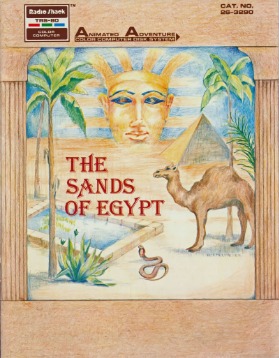
The Sands of Egypt is a 1982 graphic adventure game written by James Garon, Ralph Burris, and Steve Bjork of Datasoft for the TRS-80 Color Computer. It was licensed to Tandy Corporation and was the first disk-only game for the Color Computer sold by RadioShack. Ports to Atari 8-bit computers in 1982 and Apple II in 1983 were published by Datasoft. Set in 1893, the game follows a British explorer and archaeologist who is lost in the desert. Text commands are entered in the lower half of the screen, while a sometimes animated image of the current location is displayed in the upper half.

Shooting Arcade is a fixed shooter written by Mark Riley for Atari 8-bit computers and published in 1982 by Datasoft. It was released under Datasoft's Gentry Software budget label as Target Practice. It was ported to the TRS-80 Color Computer by James Garon and released as Shooting Gallery. The game is similar to the 1980 Sega arcade game Carnival.

Threshold is a space-themed fixed shooter written by Warren Schwader and Ken Williams for the Apple II and published by On-Line Systems in 1981. Inspired by Sega's Astro Blaster arcade video game, Threshold introduces many enemy ship types and wave formations as the game progresses. Reviewers found the variety distinguished the game from the many similar shoot 'em ups.

Dodge Racer is a maze video game programmed by Rob Re for Atari 8-bit computers and published by Synapse Software in 1981. It is a clone of the 1979 arcade video game Head On, where the player drives around a rectangular track, divided into lanes, collecting dots and avoiding collisions. Dodge Racer was the second release from Synapse and the company's first game.
















